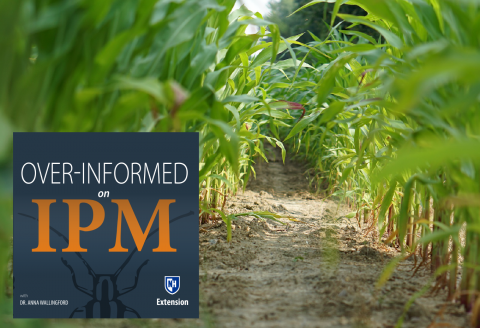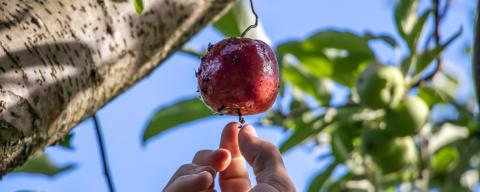Over-informed on IPM - Episode 021: Seed Treatments in Field Crops

Transcript
So I was talking to my buddy Kelly the other day
Kelly Hamby, University of Maryland
I had really called to talk about flies, well actually flies and yeasts, you know girl talk…because Dr. Hamby is the top expert in SWD-yeast interactions…but the topic of seed treatments happen to come up and I’ve always found this topic to be an interesting one from an IPM perspective and certainly more pertinent early in the season. You will hear more from Kelly later about her area of expertise – the flies and the yeasts – but I wanted to drop in on her work with seed treatments.
By seed treatments, I’m referring to fungicides and insecticides in a coating around crop seed – sometimes there will be other various and sundry growth stimulants, “bioboosters,” sometimes some “beneficial bacteria” thrown in – but the mainly fungicides and systemic insecticides. These treatments are meant to protect the seed and the newly emerging plant from diseases and from feeding pest insects. Fungicides are typically targeting soil-borne fungal pathogens. Insecticides are typically water-soluble neonicotinoid seed treatments that are taken up by the roots of the plants and translocated through the shoots, leading to protection of the whole plant from any insect that comes along and takes a chomp.
Within IPM philosophy, seed treatments are a bit of a sticky wicket. A major tenant of IPM is that you use pesticides only when necessary, usually based on something you observe in the crop… like number of bugs or % infested plants, or whatever is appropriate for the system. Cultural, physical, and biological controls are encouraged as preventative measures that avoid threshold populations… but what about preventative chemical controls. When are these justified?
Listen back to my episodes “What is IPM?” if you’re into these philosophical questions but I’m remembering my conversation with Doug Pfeiffer, who will argue that preventative chemical treatments are justified with a history of injury. If you know you had a pest problem last year, and you know enough about the pest’s biology to know it is overwintering in the crop and early is the best time to strike! Preventative applications of fungicides are the name of the game for controlling fungal diseases in fruit crops. Preventative insecticide treatments are really effective at controlling insect pests of young field crops and vegetable crops, which is especially important when the plants are young and susceptible to injury with just a little bit of insect feeding damage. Once plants mature they are more tolerant of feeding damage. This approach has eliminated the need for foliar applications of pesticides in a lot of scenarios. Actually, this approach has eliminated a LOT of foliar applications for a whole bunch of scenarios…eliminated the disruption to natural enemy complexes that sprays caused…eliminated the labor expense…the fuel to drive the tractor…I mean seed treatments have been doing some heavy lifting to improve sustainability and crop yield and quality. They are great and they should always be used in every crop always. End of podcast.
Just kidding, never say always in IPM. Never say never, either.
I asked Kelly about what we’re controlling and how long we’re talking when it comes to the residual efficacy of some of these seed treatments in the field crops she was studying at the time, things like corn, soybean, and wheat.
Kelly: Well it depends on the crop. Seed treatments are found in the plant tissue – at least at concentrations where they are active – probably about a month. The early season pests that could be controlled, at least partially controlled, are things like seedcorn maggot, cutworm, white grubs, wireworm…and actually below ground pests are some of the pests where seed treatments really are justified. You also have a little bit of aboveground protection for flea beetles, armyworm, other caterpillars.
Anna: Now Kelly had set herself and her students on a project to understand the economic value in using seed treatments field crops. Field crops are a whole lot different from vegetable crops, not just in terms of the varieties you grow and when and how you harvest them, but tolerable levels of damage are really different, so the IPM is really different.
For example, sweet corn is a pretty high input crop, you want to protect those ears from moths that lay their eggs on corn ears so that their babies don’t crawl inside, so you would go to great lengths to protect your ears – we’ll cover all of this in a later episode. But because most field corn is cow food and cows don’t really care if there’s caterpillars in their food – or at least they haven’t found a way to complain about it yet – field corn growers will tolerate a lot higher incidence of caterpillar pests in their ears, while sweet corn grower’s tolerance is right down there near zero. Field corn is a super low input crop. You really just need to protect young corn plants until they’ve grown past the whorl stage and then then its all about yields! Which are barely affected by a few chomps here and there. So you can see how important that early season seed treatment would be for field corn growers. I had Kelly get me up to speed on her project.
Kelly: What we were trying to do – and this is from a paper we just published – we were trying to measure the economic benefit of using the seed treatments and what the economic benefits were. We did some intensive sampling of the arthropod communities. We separated out all the fungicides – almost all neonicotinoid seed treatments are applied with a fungicide – so we had one treatment that was fungicide only, one that was bare seed, and two that were fungicide combined with neonic products. We compared those in terms of yield, pest damage, other economic parameters. We didn’t see any economic benefits from having seed treatments. We also saw non-target impacts, even just from the fungicide.
Anna: What were those non-target impacts?
Kelly: This is the weird thing about insect community work. We would sometimes see increases in certain groups and sometimes decreases. So sometimes we would see more spiders. I don’t know if it’s because we were dealing with intoxicated prey items. So they were doing pretty well? Or maybe they were intoxicated and easier to capture?
Where we saw our biggest impacts was in wheat. We saw long-term reductions in aphelinid wasps, which could be important biocontrol agents in that system because aphids are vectors of barley yellow dwarf virus.
Anna: I’ll just jump in here to allow you a moment to enjoy imagining intoxicated spiders – also to explain that aphelinid wasps are a parasitoid wasps of aphids. Maybe that’s obvious from the name? This group did its name as the first described species was a parasitoid of aphid species, but there are a whole bunch of species of aphelinids that parasitize other hemipterans, other bugs, and even some that parasitize other groups, including hyperparasitoids…these are parasitoid wasps that lay their eggs inside other parasitoid wasps. Parasitoids are a special kind of predator that lays its eggs inside her host. Parasites that kill their host are called parasitoids.
So it gets pretty complicated pretty fast. Yes, the seed treatments protect young plants through the early season and this protection can provide improved yields…if that is when the greatest pest pressure occurs. If sporadic pests show up later in the season, or because a pest population isn’t controlled because the spiders are all hoped up or the parasitoid wasps are suffering because there weren’t enough aphids to keep their numbers going, or a hyperparasitoid shows up that hurts the parasitoids and therefore helps the aphids. It’s kind of different from situation to situation, which makes finding clear scientific evidence in favor of one factor or another being the driving force. So should growers stop using seed treatments? I asked Kelly what she makes of this? What kind of strategy should growers use?
Kelly: It’s gotten so complicated to sort out what pest management strategies there are.
I was trying to determine what was most commonly used to make sure the field experiments we were doing were actually relevant. I was having to have people send me photos of their actual seed bags, photos of the front and the back, so I could get the little codes and decode what was in the product. It take me – someone who knows what the options are – 10 minutes to figure out what they have. If its that complicated, I feel like its pretty hard.
I’ve asked people, especially people who are extension agents that also grow “how do you pick?” and their response is “I haven’t had a problem so I don’t think about it.” So they really don’t know.
Anna: Kelly made another really important point during our conversation. Most crop insurance policies covering catastrophic losses will require that growers follow industry standards for crop protection and seed treatments are have become a critical part of what is considered industry standard for field crops. I can definitely understand why. They are very effective at doing what they were designed to do, which is protect young plants when they need it most. They save farmers a heck of a lot of time and they’ve also helped us to eliminate lots and lots of chemicals from being sprayed out in these environments. But, putting that pesticide out there every year, every field, regardless of the history of infestation …this doesn’t really sit right with me as someone who believes that pesticide should be applied only when necessary. That’s not really IPM? But, it does really drive home the point that the choice of when and where to use pesticide is not a simple one.
Before I wrap up, I want to thank Kelly Hamby of the University of Maryland and give big thanks to Jason Lightbown, who wrote and performed our theme music, but I’ll leave the last word on what to make of all this to Kelly:
Kelly: I guess I’m just destined to work on unsolvable problems, for my whole career….
Complete Show Episode List
Extension Services & Tools That Help NH Farmers Grow
Newsletters: Choose from our many newsletters for production agriculture
Receive Pest Text Alerts - Text UNHIPM to (866) 645-7010
